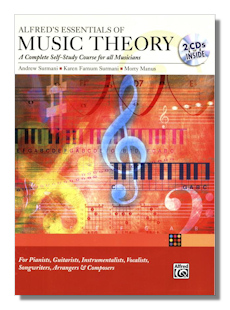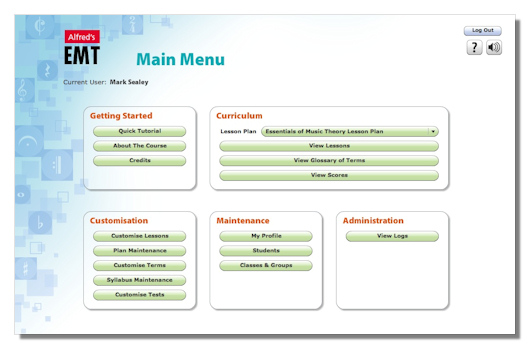
The Internet's Premier Classical Music Source
Related Links
-
Introduction
Acoustics
Ballet
Biographies
Chamber Music
Composers & Composition
Conducting
Criticism & Commentary
Discographies & CD Guides
Fiction
History
Humor
Illustrations & Photos
Instrumental
Lieder
Music Appreciation
Music Education
Music Industry
Music and the Mind
Opera
Orchestration
Reference Works
Scores
Thematic Indices
Theory & Analysis
Vocal Technique
Search Amazon
Recommended Links
Site News
Website Review
Alfred's Essentials of Music Theory
EMT on the Web
Alfred Music Publishing
http://www.emtontheweb.com/
A small amount of solid music theory is both relatively easy to acquire and extremely helpful in understanding the way classical music works. To take it more seriously and discover more can be both time consuming and potentially frustrating. Music theory can be a very technical area. Because you may find it easier to be "taught" visually and with sounds, or may consider the kind of in depth treatment found in books intimidating, and/or because you may thrive on interactivity and cross-referencing, software – specifically, online tutorials – could well prove more likely to work for you.
California-based Alfred Music Publishing has a substantial portfolio of books on music and music theory. These range from basic to advanced and include quite specialized instruction on many aspects of music. The media on which these courses can now be found include paper-based, CD, DVD, mobile apps – and now online. Their well-established and popular Essentials of Music Theory series has recently become available as an interactive resource; and is well worth a look.
Alfred's EMT Web is a subscription-based product designed to run on any browser with Flash. It is a little expensive. As a minimum, it's necessary to have a teacher's subscription ($129.99 annually) in order for even a single student to access the material – at $19.99 annually.
There is, however, a wealth of well-organized and useful material on the site. It will surely suit many users: perhaps as a refresher for those who once knew enough about music theory to be dangerous and want to revise. And certainly as a good introduction for anyone starting out who is used to interactive learning online; or those who merely want to explore music theory this way.
When you first visit the login page you get a random snippet of music (which you can silence, and which vanishes anyway once you proceed); as a teacher, you then have access to the main menu. That consists of five sub-menus:
- Curriculum: three submenus take you to the lessons themselves, where you're likely to spend most of your time; a "View Glossary of Terms" page; and one to view (your students') test scores
- Getting Started leads to three further areas of the site: an introductory tutorial (which wasn't working at the time of this review, nor was onscreen Help); a few paragraphs about "Alfred's Essentials of Music Theory Version 3 CD-ROM", on which this site is based, and which is based in turn on their popular book; and credits
- Customization: of the lessons you take; the lesson plan(s) which you construct (a very useful feature); of the syllabus and subject/topic libraries you wish to include; the musical terms you wish to add and work with; and of the selection and order of tests; you can also choose between languages: (North) American, British and Australian
- Maintenance: administration of profiles, students and classes/groups – a comprehensive way to set up, oversee, control and track progress
- Administration lets you see the activity logs of everyone (including yourself) who is using and has used the system, and how, for how long and with what (quantitative) success… exercise scores
The course is divided into three Volumes. Each Volume into six Units; each Unit contains four or five lessons, half a dozen or so ear training and text-based exercises; and your results. Each lesson consists of a handful of specific learning points displayed without fuss yet not lacking in simple, purposeful visual appeal too. The range and scope of the material is pretty comprehensive:
- Volume 1 (lessons 1-25):
- treble and bass clefs
- 4/4, 3/4 and 2/4 time signatures
- flats, sharps and naturals
- whole and half steps
- dynamic signs, tempo markings and articulation
- up to eighth notes and rests
- Volume 2 (lessons 25-50):
- major scales
- key signatures
- Circle of Fifths
- intervals
- 3/8 and 6/8 time signatures
- triads and V7 chords
- Volume 3 (lessons 51-75):
- 1st and 2nd inversions of triads
- Figured Bass
- chord progressions
- minor scales and triads
- modes
- harmonizing and composing melodies
- 12-bar blues chord progression and blues scale
- basic forms of music
Each lesson has text (which is read aloud by the [again, optional] commentary) blended with or followed immediately by graphics, animations, illustrations. In most cases these are interactive: you see how an interval changes on the staff when augmented; you can hear the notes; see how notes actually work. In the case of exercises this is very useful too… notes of smaller values must be added to produce dotted notes, for instance; the formation of scales; how time signatures work and so on. Although there are no intelligent algorithms that predict areas in which you might need re-enforcement and extra help, progress is monitored and the arithmetical results of your learning experience logged.
Understanding music theory can quickly daunt. Topics can tumble over one another in quick succession – when really understanding rhythm and meter, for instance. So the fact that "Essentials of Music Theory" is so deliberately and successfully broken into such manageable units, which can be repeated as often as needed, is all to the good. Sometimes (Unit 1, Lesson 1:d) the point is very small… the fact that the spaces on the staff can be numbered from 1-5, bottom to top. Primary Triad (Unit 16, Lesson 60:a), their formation and notation is much more substantial, though. On the other hand, the pedagogical principles on which the work is based are essentially drill and practice after explanation. However clear the explanations are, little is set in the kind of context in which many educators know we tend to learn.
The site is intended for teachers to plan courses for (their) students. To this end you can create (virtual) classes into which to put individual students and to which you assign subsets of the lessons and corresponding exercises etc. In this way you can make highly customized and specialized curricula. There is an appropriate and well-organized amount of "record-keeping": in this respect you are an administrator of students' (contact) details, Grade Limits, Pass Grade and of course which material they must learn. You could, for example, set up beginners, intermediate and advanced classes and place multiple students in each, designing course material for each which can be overlapping, comprehensive and/or very precisely targeted to their needs.
Navigation through the site is best achieved using the on-screen buttons and links; pressing the browser's "Back" button takes you out of the site instead of back to the previous page or menu. At that point the login box does not always accept the user name and you have to reload that page. It was also found that some pages and sections of the site took up to 15 seconds and longer to load (Unit 14 Review:a repeatedly stuck on 73%, for instance). Alfred's engineers are apparently planning to refine some aspects of the site's working and correct malfunctions. Hyperlinks between lessons additional to the text references would also have been useful.
The navigation on the left hand side, while logical and relatively easy to use, doesn't expand fully – either vertically, which is only to be expected with a total of 75 lessons (though control using the mouse's scroll wheel would be nice); or horizontally. This cuts off the text of lessons with longer titles like "Musical Forms - Mo"(tive and Phrase); though tooltips partially make up for this. The site is Flash-based. Forward and Back buttons inside the frames themselves take care of linear progression through the site, while you can also replay and skip lessons and exercises. The animations are excellent, clear and unambiguous and can, of course, illustrate musical points in ways that no book can. This is probably the site's biggest selling point.
The topics covered in "Essentials of Music Theory" are just those: essential to understand the basics (and somewhat beyond) of how music works. If you – or your students – thrive on a simple, usually animated, interactive teaching medium, the site may be for you. Its positive aspects also include a well-constructed syllabus; it's highly-customizable; and it's well-illustrated with – for the most part – clear and helpful explanations and expositions. The way in which students' progress can be directed, managed and logged may well appeal to Faculty and (private) tutors. The fact that a teacher account is necessary for even a single student to work at the course themselves may put off individual learners. On the negative side come some of the technical aberrations and design flaws which adversely affect operation. But it's well worth a look: if a picture tells a thousand words, an accessible and uncluttered carefully-annotated animation more than doubles that degree of communication.
Copyright © 2013 by Mark Sealey.















